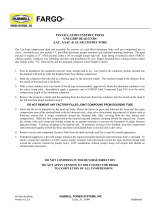Page is loading ...

FARGO
INS 893 (03/19/12) HUBBELL POWER SYSTEMS, INC.
Printed in U.S.A. Leeds, AL 35094 190893000019
METHOD OF INSTALLING LIMITED TENSION JUMPER-LOOP SPLICES
ON ACSS CONDUCTORS
Loop Splices suitable for ACSS conductors are marked with the specific conductor type, conductor diameter range,
die size, minimum press size and catalog number. ACSS loop splices are provided with center hole for joint
compound pressure relief during reverse crimping.
1. Prior to installation the conductor must be clean, straight and in-lay.
2. Mark the conductor, at a distance from end equal to the insertion depth. The insertion depth is the distance
from the open end of the splice to the knurled ring.
3. With a clean stainless steel wire brush (V-brush type recommended), aggressively brush the full circumference
of the conductor end over the full insertion length for first splice side to be compressed. Immediately apply a
generous coat of FARGO Hi-Temperature Joint Compound (HTJC) over the just brushed conductor strands.
4. Remove the protective plastic and any end plug from the splice. Select the compression die set indicated on the
splice. Mount die halves in press and lubricate die faces and crimp zone with clean oil or clean plastic bag
material. (If plastic used as lubricant, ensure that it wraps completely around the splice tube, fully covering both
die face during each compression).
5. Reverse Crimp – Use this procedure only if splice has center hole to relieve hydraulic pressure in joint
compound when second side is compressed. Remove center plug and set aside. If splice is not pre-filled,
Apply FARGO HTJC (1/2 the amount in table below per splice side) just inside the open end of the fitting bore.
If splice is pre-filled, re-distribute the bulk of the joint compound from splice center to just inside open end.
Insert one conductor end, rotating fitting to spread joint compound over conductor as it is pushed to insertion
depth. Retract the cable 1 conductor diameter (to allow for conductor strand extrusion room near splice center).
With conductor at this adjusted insertion position, start with the first compression at the open end and continue
crimping to the knurled ring. Overlap each crimp by an amount necessary to prevent the formation of ridges
between adjacent crimps. Be sure that full die closure occurs with each crimp. To prevent bowing, keep
compression zone lubricated and be sure that the splice is firmly seated in one die half while dies are closing.
With center plug still out, repeat this procedure for opposite conductor/splice end.
As reverse compressions are complete, remove joint compound expelled at center hole. If no joint compound is
expelled from filler port hole, inject HTJC16 compound to fill the center cavity completely. Hammer filler plug
into the hole until it is flush with the splice surface. (If conductor strands extruded inside the splice until the hole
is blocked at splice ID, remove some of the blocking strand with a drill bit sized to match the small end of the
tapered plug).
BEFORE REVERSE CRIMPING, COMPOUND MUST BE APPLIED NEAR THE OPEN END AS INDICATED ABOVE, TO
PREVENT POOR CONTACT HOT SPOT DEVELOPMENT IN THE CONNECTOR.
6. Loop splices without center hole pressure relief may be reverse crimped on first side only. Opposite side must
be crimped in forward direction – from knurl mark to open end after adding ½ the filler compound amount
indicated in the table below.
JUMPER LOOP SPLICES ARE MINIMUM TENSION CONNECTORS
74 75 76 20 24 27 30 34 36 38 40 42 44 48
40
Loop Splice 0.04 0.05 0.06 0.08 0.10 0.13 0.20 0.26 0.30 0.35 0.40 0.54 0.68 0.79
FARGO Hi-Temperature Joint Compound (HTJC) required (in pounds per fitting)
Catalog Series
Fitting Type
Aluminum (AH) Die Size
/



